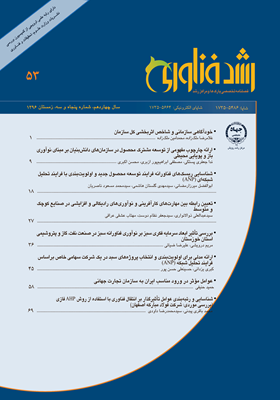شناسایی و رتبهبندی عوامل تأثیرگذار بر انتقال فناوری با استفاده از روش AHP فازی (بررسی موردی: شرکت فولاد مبارکه اصفهان)
محورهای موضوعی : Technology Transfer and Commercialization of Researchesمحمد باقری پبدنی 1 , سید محمدرضا داودی 2
1 - موسسه غیر انتفاعی امین
2 - دانشگاه ازاد اسلامی واحد دهاقان ،گروه مدیریت
چکیده مقاله :
در کشورهای توسعهیافته انتقال فناوری ممکن است که یکی از راهحلها برای رشد بخشهای اقتصادی و صنعتی باشد. با این وجود موفقیت انتقال فناوری به طرز قابل توجهی به انتخاب مناسب فناوری از منابع مناسب، بستگی دارد. هدف از پژوهش حاضر، شناسایی و ارزیابی عوامل تأثیرگذار بر انتقال فناوری با استفاده از روشAHP فازی میباشد. انتقال فناوری میتواند در راستای نوآوری محصولات و اجرای بهتر فرایندها، راهکارهای افزایش بهرهوری و اثربخشی، سهم بیشتر از بازار و افزایش سود به سازمان کمک کند و این امر برای شرکتهای کوچک و متوسط به دلیل اندازه و محدودیت منابع آنها مفید میباشد. در این تحقیق، با استفاده از روش تحلیل محتوا با بررسی پیشینه تحقیق و سپس با استفاده از نظرات کارشناسان و افراد خبره 24 عامل تأثیرگذار مشخص و در 5 بعد شامل: مزیت نسبی در شرایط اقتصادی، بازاریابی مزایا و نیروهای مربوط، ویژگیهای فنی، ملاحظات قانونی و نظارتی و مسائل راهبردی و مدیریتی دستهبندی شدهاند. از روش AHP فازی جهت رتبهبندی ابعاد عوامل تأثیرگذار و ساختارهای مربوط به هر یک از این ابعاد استفاده شده است. با توجه به نتایج، مهمترین معیار در زمینه انتقال فناوری شرکت فولاد مبارکه، سازمانهای بینالمللی از زیرمجموعه شاخص اصلی ملاحظات قانونی و نظارتی میباشد که براساس آن استفاده فنی و تأمین مالی از سازمانهای بینالمللی و سازمانهای همکاری مشترک که دارای قوانینی در جهت همکاریهای مشترک برای بهبود محیطزیست میباشند، نقش مهمی در انتقال فناوری ایفا مینماید. پیشنهاد میشود شرکت مذکور با استفاده از نیروی انسانی ماهر و ایجاد سازوکار مناسب در جهت استفاده حداکثر از مزایای استفاده از این نوع فناوریها در آیندهای نزدیک گامهای مؤثری از سوی مدیران و کارشناسان شرکت فولاد مبارکه برداشته شود.
In developed countries, technology transfer may be one of the solutions for the improvement or growth of economic or industrial sectors. However, the success of technology transfer significantly depends on the appropriate choice of technology from the appropriate resources.The aim of this study is to identify and evaluate the effective factors of technology transfer using fuzzy AHP method. Technology transfer can be helpful for this organization in market share and increasing return through innovation of products and better execution of processes, methods of increasing productivity and effectiveness, and this is beneficial to small and normal company’s with limited resources and sizes. In this paper, after reviewing the literature and using expert’s opinion, 24 effective factors is identified which are in 5 categories which includes is: relatively advantageous in financial conditions, advantage marketing and related forces, technical characteristics, juridical and supervision considerations and issues of directorial and guideline. Furthermore, fuzzy AHP method is used to rank the dimensions and structures of these effective factors. Due to the results, the most important criterion in the field of technology transfer of Esfahan’s mobarakeh steel company (MSC) and international organizations of subclasses of the main indicator is juridical and supervision considerations,of foreign investment and based on this the technical use and financing from international organizations and cooperative organizations that have laws about cooperation for improving the environment have an important role in technology transfer.


